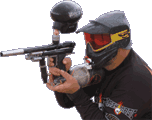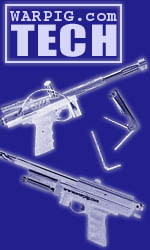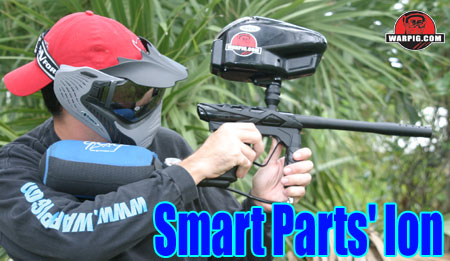
Smart Parts' Ion
By Bill Mills - Photos
by Dawn Mills - Aug 2005
Overview
- How It Works - Disassembly
- Testing - Raw Test Data
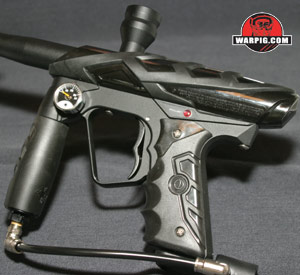 Every
so often, a manufacturer develops a paintball gun that sets a new standard
for price and performance categories. Brass Eagle showed the world
that a semi-auto could sell for less than $200 when they released the Stingray.
Kingman followed suit, showing that a paintgun with a metal receiver could
be done in that same price point. Later Dragun delivered an electronically
triggered semi for under $200. When it released the Ion, Every
so often, a manufacturer develops a paintball gun that sets a new standard
for price and performance categories. Brass Eagle showed the world
that a semi-auto could sell for less than $200 when they released the Stingray.
Kingman followed suit, showing that a paintgun with a metal receiver could
be done in that same price point. Later Dragun delivered an electronically
triggered semi for under $200. When it released the Ion,
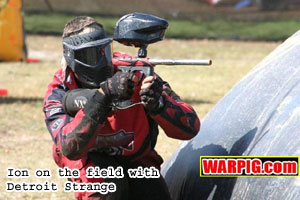 Smart
Parts showed that an electropneumatic paintgun could be delivered in quantity
for less than three hundred dollars. Smart
Parts showed that an electropneumatic paintgun could be delivered in quantity
for less than three hundred dollars.
The Ion represents a simplification
of the technology found in the more expensive Shocker SFT, meaning that
it is less expensive to produce, and in some aspects simpler to maintain
due in part to the low number of overall parts, and very few moving parts.
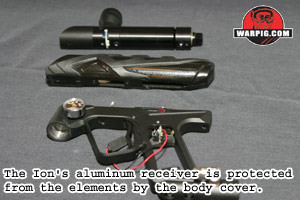 When
the Ion was first shown to the public at the Paintball Expo in Southern
California, some of its first critics complained that it was a “plastic
gun.” In reality, the Ion features plastic and rubber like covers
over various parts, much like other paintgun designs feature plastic grip
panels and eye covers. The actual structural components of the Ion
are machined from aluminum at Smart Parts’ Pennsylvania factory. When
the Ion was first shown to the public at the Paintball Expo in Southern
California, some of its first critics complained that it was a “plastic
gun.” In reality, the Ion features plastic and rubber like covers
over various parts, much like other paintgun designs feature plastic grip
panels and eye covers. The actual structural components of the Ion
are machined from aluminum at Smart Parts’ Pennsylvania factory.
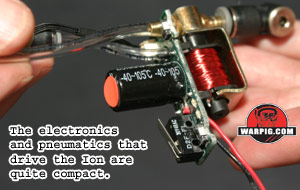 The
Ion’s grip frame features an integrated ASA threaded connector for the
gun’s vertical regulator, as well as a side tap for a low pressure gauge.
Inside the grip frame lies a 9 volt battery for power, and a very small
circuit board, relative to those found in most electronic paintball guns.
Like the rest of the Ion’s design, there is a minimalist approach to the
board. Its major components consist of the on/off switch, an internal
mode setting switch, a high-flow solenoid valve, a capacitor, and the trigger
switch. The remaining components include tiny surface mount diodes,
and a rather tiny processor. The
Ion’s grip frame features an integrated ASA threaded connector for the
gun’s vertical regulator, as well as a side tap for a low pressure gauge.
Inside the grip frame lies a 9 volt battery for power, and a very small
circuit board, relative to those found in most electronic paintball guns.
Like the rest of the Ion’s design, there is a minimalist approach to the
board. Its major components consist of the on/off switch, an internal
mode setting switch, a high-flow solenoid valve, a capacitor, and the trigger
switch. The remaining components include tiny surface mount diodes,
and a rather tiny processor.
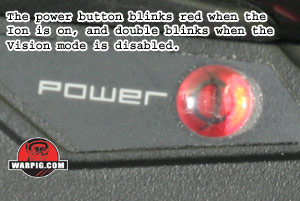 At
the top left side of the grip frame is a plastic bubble button. This
button serves two functions. It depresses the actual power button
on the circuit board, and it acts as a window to see the status LED on
the circuit board. At
the top left side of the grip frame is a plastic bubble button. This
button serves two functions. It depresses the actual power button
on the circuit board, and it acts as a window to see the status LED on
the circuit board.
The grip section of the frame is angled
like a typical grip, and features screw points to accept standard 45 style
wrap-around or panel grips. The stock wraparound grip from Smart
Parts has two finger groves below the trigger guard, and decorative ribbing
that echoes the patterns on the rest of the gun. At the bottom of
the grip frame is a typical duckbill style bottom-line ASA or Air System
Adapter. Both the ASA and the grip frame are finished in a rugged
matte industrial powder coat.
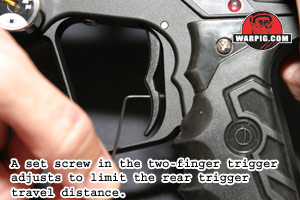 The
trigger itself is a two-finger design of molded polymer. Rather than
a spring it features a magnetic return, and screw adjustments for both
the forward and rear travel limits. The rear arm of the trigger presses
up against a lever switch on the circuit board to fire. A nice feature
to the Ion’s trigger is that both adjustment screws are accessible from
the outside of the trigger frame, making full adjustment rather simple. The
trigger itself is a two-finger design of molded polymer. Rather than
a spring it features a magnetic return, and screw adjustments for both
the forward and rear travel limits. The rear arm of the trigger presses
up against a lever switch on the circuit board to fire. A nice feature
to the Ion’s trigger is that both adjustment screws are accessible from
the outside of the trigger frame, making full adjustment rather simple.
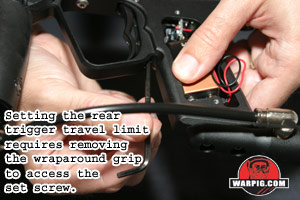 From
the factory, the Ion reviewed had a trigger pull of 0.104 inches, measured
at the bottom of the trigger. Less than a minute of adjustment was
needed to bring the trigger pull down to reliable operation at 0.071 inches.
The forward limit screw changes not only how far the trigger must be pulled
before it actuates the trigger switch, but also how hard it must be pulled,
as it distances the trigger return magnets from each other. From
the factory, the Ion reviewed had a trigger pull of 0.104 inches, measured
at the bottom of the trigger. Less than a minute of adjustment was
needed to bring the trigger pull down to reliable operation at 0.071 inches.
The forward limit screw changes not only how far the trigger must be pulled
before it actuates the trigger switch, but also how hard it must be pulled,
as it distances the trigger return magnets from each other.
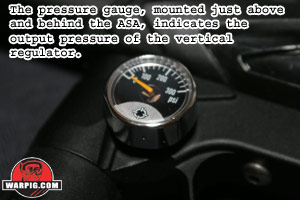 At
the front of the grip frame is the ASA, into which the vertical regulator
is connected. A rubber-like armor sheath protects the body of the
vertical reg while providing a positive gripping surface. The regulator
is adjusted by turning wrench flats on its bottom, while gripping the regulator
body. This adjusts the pressure fed into the Ion, which can easily
be read on the left side pressure gauge. At
the front of the grip frame is the ASA, into which the vertical regulator
is connected. A rubber-like armor sheath protects the body of the
vertical reg while providing a positive gripping surface. The regulator
is adjusted by turning wrench flats on its bottom, while gripping the regulator
body. This adjusts the pressure fed into the Ion, which can easily
be read on the left side pressure gauge.
Inside the vertical ASA, a fine screen
prevents debris from being fed into the solenoid valve. The Ion is
designed to operate at under 200 psi, with typical setups running between
160 and 180 psi. Adjusting the pressure is one of the two ways to
change the Ion’s velocity. Because of the standard ASA threading,
the stock regulator can be replaced with any number of aftermarket vertical
regulators.
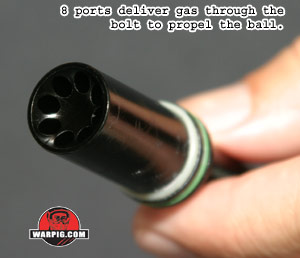 Attached
to the grip frame by three screws is the Ion’s receiver. Two screws
come from below the receiver into threaded holes in the body, while another
goes from the receiver down into the grip frame just forward of the vertical
ASA. The body shell, the receiver’s equivalent of a wrap-around grip,
slides off of the receiver once it is separated from the grip frame and
hoses. Attached
to the grip frame by three screws is the Ion’s receiver. Two screws
come from below the receiver into threaded holes in the body, while another
goes from the receiver down into the grip frame just forward of the vertical
ASA. The body shell, the receiver’s equivalent of a wrap-around grip,
slides off of the receiver once it is separated from the grip frame and
hoses.
The receiver itself consists of two
main components. The Body Breech is in the front and holds the feedneck,
barrel threads, SFT o-ring, ball detents and anti-chop eyes. Screwed
into the back of the body breech is the fire chamber, the portion of the
receiver, which contains the combination bolt and valve core. Three
captured o-rings inside the feed-neck allow it to snugly grip a hopper.
Like the Shocker SFT and Nerve, the Ion features a Seal Forward Technology
o-ring. By placing the o-ring which seals the breech in the receiver,
rather than on-the bolt, the bolt’s friction is reduced without losing
the benefits of a seal.
The main parts of the receiver are hard
anodized, but the sections of the body breech and feed neck which are exposed
outside of the body shell are powder coated to match the grip frame.
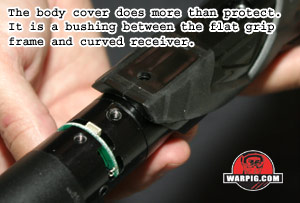 In
addition to serving as a protective guard for the receiver, the body shell
acts as a bushing between the receiver and the grip frame. It cradles
the round surface of the receiver bottom to the flat surface of the grip
frame top, without allowing the parts to wobble. This interface is
one of the design steps which helps reduce the manufacturing cost of the
ION. Molded parts like the body shell have a significant up-front
cost in manufacturing injection molds, but once into production, they can
be produced inexpensively, even if they have rather complex shapes.
The machined receiver and grip frame parts on the other hand are more expensive
when they get more complex, as more time is needed milling and lathing.
The use of the body shell avoids either needing to radius the top of the
grip frame to a concave curve, or having to mill a flat bottom onto the
receiver (which would be a tricky process as it would require fixed thread
alignment between the body breech and fire chamber.) In
addition to serving as a protective guard for the receiver, the body shell
acts as a bushing between the receiver and the grip frame. It cradles
the round surface of the receiver bottom to the flat surface of the grip
frame top, without allowing the parts to wobble. This interface is
one of the design steps which helps reduce the manufacturing cost of the
ION. Molded parts like the body shell have a significant up-front
cost in manufacturing injection molds, but once into production, they can
be produced inexpensively, even if they have rather complex shapes.
The machined receiver and grip frame parts on the other hand are more expensive
when they get more complex, as more time is needed milling and lathing.
The use of the body shell avoids either needing to radius the top of the
grip frame to a concave curve, or having to mill a flat bottom onto the
receiver (which would be a tricky process as it would require fixed thread
alignment between the body breech and fire chamber.)
Suffice it to say, that the body cover
is a necessary part for the Ion, though aftermarket aluminum bodies are
available for those who prefer the look, and or desire additional weight.
For proper function, a minimal body cover replacement would need only to
consist of a mounting rail between the receiver and grip frame, with winged
panels around the eye circuit and ball detents.
Continue to HOW
IT WORKS. |

